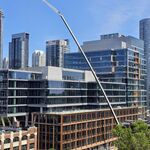I'm not about to defend Turban Planner, and am as pro-cycling as they come pretty much; but I do think the rah rah for everyone can do it and in all weather and at all times of year is just too over the top.
Many people aren't in the physical shape required...........they'd be exhausted/sore and maybe risking a heart attack by the 10th block (1.5km) never mind their typical commutes, which for many are 20km ++
Additionally, many people don't own and can't afford top notch winter gear, there are a lot of working class folks who struggle to get generic winter jacket number 2 from Walmart and a pair of mittens or gloves, the idea that everyone can afford their hyper-insulated, breathable, sweat-wicking, stain-resistant, rip-stop gear along with a good bike is just disconnected from reality.
That's before considering the theft issue noted above, and even lack of covered, never mind secure bike storage at one's workplace (or residential) destination.
Most apartments in Toronto lack ground floor or in-garage bicycle storage. You have to haul a bike into an elevator, then pop it up on end, making a mess of the cab and driving the management nuts, while occupying almost the entire elevator and inconveniencing your fellow tenants.
Trying do that twice a day (or 4x if you have extra errands to run) and some of you will give up biking.........
There's also the matter of having showers and a change of clothes when you get to work.
You know most workplaces don't offer this, right?
*******
Now, let's be clear, I'm pro cycling as much as ever and don't like tired trope arguments against it. But I don't think those are countered by statements that have every bit as much slant/spin and are equally off the mark.
The object is not to get everyone to bike, there is no believable scenario for this in most of the GTA and there won't be in 10 years either. The objective is:
a) Make it much safer and more pleasant for existing riders
b) Raise the modal split for cycling substantially, in areas of high cycling from 10/15% to 25% or more; in areas of low cycling ~2%, the realistic object is to get that to ~10% over a few years and 15% within 15 years.
c) Getting even that done requires a lot of heavy lifting:
-We need retrofits to existing work places, with government leading by example, offering secure, indoor, bike parking and showers at most workplaces.
- We need a vastly expanded Bikeshare system. Just to cover the City proper will require ~1,400 bikes or so, but if you think of near universal uptake, and most bikes going one way per peak-hour, that's only 1,400 commuters using bikes. Making a larger difference means thinking about a system the size of Paris, Velib for the GTA, - 19,000 bikes, with roughly 6,000 of those in the City proper.
- It means free Canbike level one for every school child and every adult who wants to learn to ride.,
- It means mandating landlords to provide secure, ground-floor bike storage, wherever possible (displacing surfacing parking/carports)
- The government should lead by providing this at major TCHC projects.
- It also means snowmelt systems around catch basins/road drains to reduce the liklihood of ice buildup when roads are reconstructed.
- Don't forget a need for more year-round public washrooms, as not everyone can hold it for another 2km until they pass an open fast food place or such.
****
Lets rightly defend the installation of these lanes, while seeing if we can't reduce some of their worst impacts.
But lets also champion the above...........and while we're getting 'the carrot' right..........we need 'the stick' too, of highway tolls and of higher permit parking rates that reflect fair market value.




